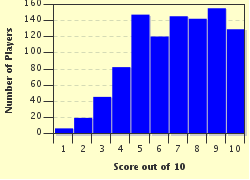Quiz Answer Key and Fun Facts
1. The city of Jerusalem was besieged from 589 BC before falling in 587 BC to which king of Babylon, who is mentioned in the Bible?
2. The Siege of Mafeking lasted from October 1899 until May 1900. In which country did this take place?
3. Which island came under constant siege from the air forces of Italy and Germany between June 1940 and November 1942 and was awarded the George Cross in recognition of its resistance?
4. 1383 saw the siege of which town in the country now known as Belgium? It went on to suffer again in several major battles of the first World War.
5. The Siege of Candia (in Crete) lasted from 1648 until 1669, making it among the longest in history. The town was held by Venice and was besieged by which forces?
6. The Indian Rebellion, or Indian Mutiny, of 1857 saw sieges at various locations in northern India. Which of these is *NOT* one of them?
7. The city of Dubrovnik came under siege between October 1991 and May 1992 during the breakup of Yugoslavia. In which country is Dubrovnik situated?
8. Calais has suffered from several sieges in its time. The one between 1346 and 1347 took place during which of these wars?
9. The Siege of Masada took place in 72 or 73 AD during the first Jewish-Roman war, with the Romans besieging the Jews. According to the historian Josephus, how did the siege end?
10. The Sieges of Drogheda, Waterford and Clonmel took place in 1649 and 1650 when forces led by which man reclaimed Ireland for England?
Source: Author
rossian
This quiz was reviewed by FunTrivia editor
bloomsby before going online.
Any errors found in FunTrivia content are routinely corrected through our feedback system.

